Losing weight isn’t just about eating less—it’s about eating smarter. One of the best ways to do this is by understanding macronutrients, or “macros.” Macros are the three main nutrients your body needs: protein, carbohydrates, and fats. Learning how to balance them can help you lose weight while staying energized and satisfied.

Let’s break it down step by step.
What Are Macros?
Think of macros as the building blocks of your food:
- Carbohydrates: These are your main source of energy. They’re in foods like fruits, vegetables, and root crops like sweet potatoes.
- Proteins: These help repair and build muscles. You’ll find them in well-sourced options like lean meats, fish, eggs, or plant-based options like lentils.
- Fats: These support hormones and help your body absorb vitamins. Healthy fats come from foods like avocados, nuts, seeds, and olive oil.
Each macro plays a role in keeping your body running smoothly. The key is getting the right balance for your goals.
Step 1: Know How Many Calories You Need
First, figure out how many calories your body uses in a day. This includes the calories you burn just to stay alive (like breathing and sleeping) plus any activity, like walking or working out.
You can use an online calculator to estimate this number. For example, if your body needs 2,000 calories a day to maintain your weight, eating less than that—say, 1,500 calories a day—can help you lose weight.
Step 2: Set Your Macro Goals
Once you know your calorie target, you can divide those calories into macros. A good starting point for weight loss is:
- 40% carbs: For energy. Think of foods like fruits, root vegetables, and quinoa.
- 30% protein: To keep you full and help maintain muscle. Go for well-sourced options like grass-fed beef, wild-caught fish, or organic poultry.
- 30% fats: For healthy hormones. Use sources like olive oil, avocado, or nuts.
For example, if your goal is 1,500 calories a day, that’s about:
- 600 calories from carbs (40%)
- 450 calories from protein (30%)
- 450 calories from fats (30%)
Step 3: Focus on Quality Foods
Not all calories are created equal! Choosing nutrient-rich foods will help you feel full longer and support your health. For example:
- Carbs: Pick whole fruits, root vegetables like sweet potatoes, or quinoa instead of processed options.
- Proteins: Prioritize well-sourced lean meats, eggs, fish, or plant-based options.
- Fats: Use olive oil, eat a handful of nuts, or slice up an avocado instead of reaching for fried foods.
Step 4: Take It One Day at a Time
Tracking your food can be a helpful tool at first, but don’t let it stress you out. The goal isn’t to be perfect—it’s to build habits that work for you. Over time, you’ll start to recognize portions and find meals that keep you full and happy.
Takeaway:
Balancing your macros helps you eat in a way that supports your weight loss goals without feeling deprived. It’s not about cutting out food groups—it’s about finding the right balance that works for your body.
Want to get started with a plan that’s personalized to you? Check out my trainer profile for expert guidance and support on your journey!



